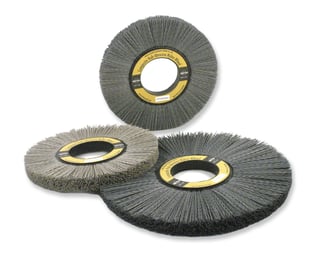 Gear manufacturers need to meet tough requirements for dimensional accuracy, tooth spacing, and gear form. To remove burrs and improve surface finish, nylon abrasive wheel brushes are used. For both machine-based and off-hand deburring, NamPower wheel brushes from Brush Research Manufacturing (BRM) are an excellent choice.
Gear manufacturers need to meet tough requirements for dimensional accuracy, tooth spacing, and gear form. To remove burrs and improve surface finish, nylon abrasive wheel brushes are used. For both machine-based and off-hand deburring, NamPower wheel brushes from Brush Research Manufacturing (BRM) are an excellent choice.
NamPower wheel brushes feature nearly-indestructible cores and long-lasting nylon abrasive filaments. These high-performance industrial brushes are a safe, durable alternative to wire wheels and non-woven abrasives. With their well-balanced construction, NamPower wheels reduce machine fatigue. There’s less filament breakage, too. Plus, NamPower technology supports shorter cycle times.
For gear manufacturers who want to know more about NamPower wheel brushes, here are some basics to get you started on the road to gear deburring and surface finishing success.
Gear Materials and Nylon Abrasive Filaments

Gear manufacturers can choose NamPower wheel brushes with either silicon carbide or diamond abrasive. The gear’s base material determines which abrasive type to select. The deburring and surface finishing requirements determine which grit or mesh size to choose.
Silicon carbide abrasive is recommended for steel gears and comes in coarser and finer grit sizes. Choose coarser grits for heavy-duty deburring, and then use a finer-grit brush for final gear finishing.
Diamond abrasive is recommended for gears made of hardened tools steels and other harder materials. NamPower wheel brushes that use diamond abrasive come standard in 600 mesh, but BRM can provide additional mesh sizes upon request.
Gear Finishing and Wheel Brush Dimensions
BRM offers NamPower wheel brushes in different diameters. As a rule, the diameter of a NamPower wheel should be larger than the cutting tool that was used to machine the gear. The brush's face width must be wide enough to deburr a wide edge, but narrow enough to access part recesses that must need finishing.
For gear deburring and finishing, it’s also important to note the relationships between tool diameter and flexibility vs. aggressiveness.
- Larger-diameter tools are less aggressive and more flexible.
- Small diameter tools are less flexible and more aggressive.
Trim length, also affects flexibility and aggressiveness.
- Longer trim lengths are less aggressive and more flexible.
- Shorter trim lengths are less flexible and more aggressive.
Learn More. Get the NamPower Resource Guide.
Are you are gear manufacturer, or do you need more information about NamPower wheel brushes for gear deburring and finishing? The article you just read provides an overview, but you’ll find complete product specifications and operating parameters in the NamPower Resource Guide, a free technical publication from BRM.









